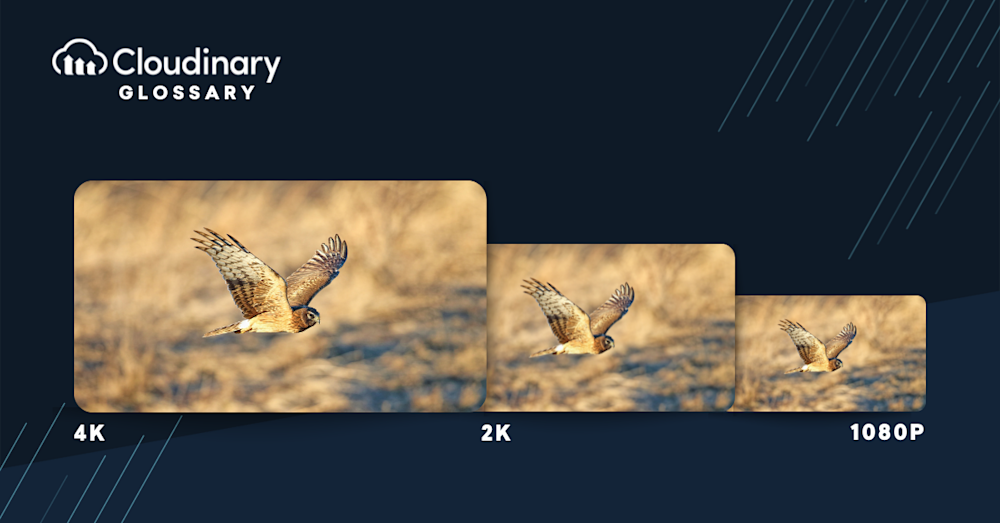What Are Video Resolutions?
Video resolution refers to the number of pixels displayed in each dimension, determining the clarity and detail of a video. Common types of video resolution include 480p (Standard Definition), 720p (HD), 1080p (Full HD), 2K (Quad HD/QHD), 4K (Ultra HD), and 8K. Higher resolutions like 4K and 8K provide greater detail and sharpness, especially on larger screens, but also require more storage space and higher bandwidth for streaming.
Choosing the right resolution depends on factors such as the viewing device, screen size, available bandwidth, and the type of content being displayed. For example, 4K is ideal for large screens and professional content, while 720p or 1080p may be more suitable for smaller screens or limited bandwidth scenarios. Understanding these different types of video resolutions helps ensure you select the optimal quality for your needs and audience.
- “Standard Definition” 480, 576: These are a measurement of the total number of pixels running across a vertical line down the display. These are the resolutions of yesteryear, common in Standard Definition and old media. Specifically, 480p, often seen with a 4:3 aspect ratio, has been a good match for laptops and desktop monitors, offering a basic level of clarity and video quality suitable for smaller screens.
- “High Definition” 720, 1080: These are a measurement of the total number of pixels running across a vertical line down the display. These are most common in lower-end devices, with 1080p known as “Full HD”. The 1080p resolution typically features 1920×1080 pixels, and it has become the standard for mobile phones due to its balance of quality and performance. On the other hand, 720p, with 1280×720 pixels, offers more than twice the sharpness of 480p and is suitable for larger screens compared to standard definition.
- 2K, 4K, 8K, and Ultra High Definition: These are a measurement of the total number of pixels across a horizontal line on a display. These are becoming more common in mid to high end displays, with 4K quickly becoming the most popular option of the three. 4K resolution, offering 3840 x 2160 pixels, has become a standard in high-end consumer electronics, providing exceptional clarity and detail. Similarly, 8K resolution significantly enhances quality, especially noticeable when zooming in on far-away scenes, thanks to its high pixel count. Additionally, 1440p or Quad HD, with a maximum resolution of 2560 x 1440 pixels, is particularly popular among gamers for its superior detail and performance.
A note on terminology: The “p” stands for progressive scan, meaning each full frame is drawn sequentially from top to bottom rather than in alternating lines (as with interlaced, or “i,” formats). The numeric part always refers to the vertical pixel count; the number of horizontal lines from top to bottom of the image.
The higher the number of pixels you want for your video, the larger the file size. But your resolution also affects how clear the video is. With lower resolutions, you’ll have far fewer pixels on screen to add definition and detail to an image, making it far lower quality. It’s like watching an old VHS tape compared to the same film on Blu-Ray; the higher definition and frame rate add detail, clarity, and smoothness.
Which Video Resolution Is Best?
In reality, there isn’t one true resolution to rule them all. Instead, you’ll want to aim to have your video at the highest possible resolution and allow technology to take care of the rest.
With the current trend of technology, there are a vast number of displays in the world, all with different aspect ratios and resolutions. So instead of using one single resolution, you’re better off changing it to fit the user’s device. This is why popular sites like Twitch and YouTube allow you to change it as needed.
Modern delivery platforms use adaptive bitrate streaming to automatically switch between different combinations of resolution and bitrate based on the viewer’s bandwidth and device capabilities. This ensures that users receive the highest possible quality without interruptions, moving seamlessly if network speeds drop.
By dynamically changing the resolution of your video, you can offer the best viewing experience possible for each individual user and device.
How to Choose the Right Video Resolution
When deciding which video resolution to use, consider the intended viewing device, screen size, available bandwidth, and the type of content. For example, 4K resolution is ideal for large screens and professional or cinematic content, providing exceptional detail.
In contrast, 720p or 1080p may be more appropriate for smaller screens, mobile devices, or situations where bandwidth is limited. Higher resolutions like 8K offer the most clarity but require significant storage space and processing power, making them suitable for specialized use cases such as professional filmmaking or scientific imaging.
Industry Acronyms & Exact Dimensions
- FHD (Full HD) refers to 1080p (1920×1080 pixels), the most widespread “crisp HD video” standard.
- UHD (Ultra HD) typically refers to 4K (3840×2160 pixels), delivering roughly four times the pixel count of 1080p.
- 8K (Ultra HD) is precisely 7680×4320 pixels, offering sixteen times more pixels than 1080p for
Typical Use‑Cases by Resolution:
- 720p (HD): Common for webcams, video calls, and basic online streaming due to lower bandwidth requirements.
- 1080p (FHD): The go‑to standard for most online video platforms, corporate presentations, and general-purpose TV/monitor use.
- 4K (UHD): Favored for high‑end TVs, gaming monitors, and cinematic content where greater detail enhances the experience.
- 8K (Ultra HD): Still emerging; used in professional filmmaking, premium broadcast, and specialized scientific or medical imaging where maximum detail is crucial.
Stay Fresh with Cloudinary
Video resolution is a tricky topic, and it’s easy to get lost in the numbers. However, understanding the basics of each resolution is key to making sure you’re choosing the right one for your project.
And with Cloudinary, you can make sure that your users are getting the best resolution for their devices.
If you want to get started with Cloudinary, you can sign up for a free account today!
Additional Resources You May Find Useful:
- Convert Image to PNG
- Convert Image to AVIF
- Convert Image to WEBP
- Convert Image to JPG
- Convert Image to GIF
- Convert SVG to JPG
- Convert SVG to PNG
- Convert SVG to GIF
- Convert SVG to WEBP
- Convert SVG to AVIF
- Convert TIFF to JPG
- Convert TIFF to PNG
- Convert TIFF to GIF
- Convert TIFF to WEBP




